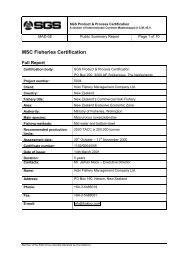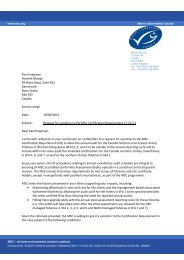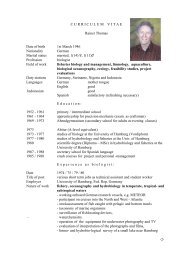SGS Product & Process Certification - Marine Stewardship Council
SGS Product & Process Certification - Marine Stewardship Council
SGS Product & Process Certification - Marine Stewardship Council
Create successful ePaper yourself
Turn your PDF publications into a flip-book with our unique Google optimized e-Paper software.
short-term forecasts and setting TACs. However, the output can still be used to give sound<br />
precautionary management advice in relation to stock status and sustainability. For example,<br />
selectivity patterns in the UK fishery have already been used in simulations of increases in the<br />
size at which bass are first exploited (due to a potential increase in MLS) to indicate the relative<br />
magnitude of changes in yield to the various métiers and in the age structure of the underlying<br />
bass population (M. Smith, Cefas, pers. comm.). The results were similar to and updated those<br />
obtained by Pawson et al (2005), indicating that Y/R gains (and losses) with progressive<br />
increases in the MLS (above 36 cm) were gear specific, but were likely to provide most benefit<br />
to rod-and-line fisheries and least to trawl and net metiers.<br />
3.3.3 Biological reference points<br />
The common patterns in the recruitment time-series for sea bass ―stocks‖ in the North Sea,<br />
English Channel, and along the west coast of England and Wales indicate that sea bass<br />
populations around England and Wales are linked biologically (see Pickett et al., 2004) and/or<br />
that recruitment is controlled by large-scale environmental patterns. It is known that warm or<br />
cold summers and winters can have a considerable influence on the survival of 0-group bass<br />
through their first year (Kelley, 1986), and that strong year classes are associated with higher<br />
temperatures (Pawson, 1992; Pawson, 2008) rather than SSB. There is, therefore, no stockrecruit<br />
relationship for bass that could be modelled, either to explain past or to predict future<br />
recruitment patterns (Pawson et al., 2007b). The relative size of the spawning stock bears no<br />
relationship to past recruitment over the period for which data are available (1984 – 2008),<br />
which means that it has not been possible to set absolute or even relative reference points<br />
based on stock-recruit considerations. There is, however, no sign of recruitment-overfishing,<br />
and management decisions have been taken based on considerations of Y/R and MSY in<br />
relation to exploitation patterns (essentially F-at-age, based on a good knowledge of biological<br />
parameters and local fishing patterns).<br />
3.3.4 Scientific background to management advice for sea bass<br />
Research on the sea bass and its fisheries started in the 1970s, when recreational anglers in<br />
particular began to be concerned for the future of the bass stocks around the coasts of<br />
England, Wales and Ireland. What little was known of its biology was, nevertheless, sufficient<br />
to indicate that protection of juveniles was bound to assist conservation of bass (Holden and<br />
Williams, 1974). Though ICES established a study group in 2001 to respond to the European<br />
Commission‘s request for information on sea bass fisheries, stock identity, assessment data<br />
and conservation requirements in European waters (ICES, 2002), there was no assessment of<br />
the size of the bass population - even in relative terms - and of its productivity and mortality<br />
rates until 2003, and thus any restraint on exploitation (if this was necessary) could not be<br />
justified on the basis of an analytical assessment.<br />
In the UK, however, a scientific recommendation to increase the sea bass MLS above the then<br />
current 26 cm (Holden and Williams, 1974) resulted in a dedicated research programme<br />
initiated by Cefas in 1981, the publication of a summary of the results of which (Pawson and<br />
Pickett, 1987) served as an aide memoir for forthcoming discussions and consultations on<br />
management measures. This included a Y/R analyses that showed strong evidence of growthoverfishing<br />
in many areas around English and Welsh coasts, owing to local fisheries targeting<br />
3-5 year-old sea bass in and around harbours and estuaries. It was concluded that an MLS of<br />
36 cm would satisfy the management objective of reducing growth-overfishing, whilst allowing<br />
some important small-boat fisheries to remain viable.<br />
Page 24 of 151





